|
More Articles
Scrambling to the top
The gardener who owns a pergola is a lucky person indeed. Not only do these structures add an entirely new dimension to a garden, they bring with them a wonderful opportunity to grow some beautiful and interesting climbers, in fact as far as plant choice goes, the sky’s the limit! The world is full of an amazing array of plants that would be only too happy to scramble and twine their way up those supports, but before you start digging the planting holes, you will need to take a few moments to assess the situation and decide which type of climbers would make good tenants for your pergola. If you have a grand scale structure the likelihood is that you will be aiming for equally imposing plants. Something fairly vigorous to cover a large expanse and make a statement, a plant that combines both beauty and spirit. If this is the case then you need look no further than Wisteria, a natural born show off. A deciduous, woody twiner, it will wind its way up the pillars, clothing large areas in a short space of time. In late April, just before the leaves emerge, the long plump soft and hairy buds give a tantalizing hint of the spectacle to come. A month later it drips with long tassels of sweetly scented flowers and is covered with a mass of luxuriant leaves. Blue is the most familiar colour but white and pink flowering types are also available. There are many named varieties of the Chinese Wisteria sinensis or Japanese Wisteria floribunda, each with their own merits. The Trumpet Vines, Campsis, are also remarkably showy, with glossy deep green leaves that are an excellent backdrop for the gloriously brash bright flowers. The variety ‘Madame Galen’ bears intense orange-red trumpets in the late summer. These climb using aerial roots, so will need stout pillars and crossbars. A special point to note about Campsis is that the ones planted in poor soil will flower more profusely than those that are given fertile dwellings! Now what about Passiflora caerula? This rampant semi-evergreen has glossy, deeply lobed leaves and white and blue flowers that resemble exotic jellyfish from early summer until late autumn. It climbs by means of tendrils, so will want something to grab onto for its journey upwards. Of course we mustn’t forget about the madly rampant Clematis montana clan. Flowering for about a month in late spring, these plants have the ability to cover huge areas in a short space of time. The blooms are quite small, but the plant smothers itself in them, creating quite a dramatic show. There are lots of varieties available, but a real gem among them is ‘Marjorie’ with double creamy-pink flowers. Clematis armandii is a fast growing evergreen; suitable for those who don’t like looking at bare stems in wintertime. Richly scented clusters of starry white flowers adorn this plant in March and April. The large glossy leaves would make a marvellous backdrop to a host of summer flowering climbers. Rambling roses are very romantic and the minds-eye conjures a vision of loveliness to be enjoyed in high summer. But remember these vigorous shrubs have a single flush of flowers that are quickly followed by very thorny, questing branches that will need regular tying-in to prevent entanglement with your face and body! Maybe they are best left to pillars and big trees. The golden hop, Humulus lupulus ‘Aureus’ is a delightful deciduous fast growing twiner with bright yellow, roughly textured leaves. Whilst all the other plants mentioned so far will enjoy a bright sunny spot, the leaves of this can scorch if placed in full sun, so a smidgen of shade is best in this instance. In late summer these plants bear swags of richly scented hops. To add an extra touch of zing to this you could partner it up with one of the large flowering clematis, maybe a deep purple such as the ever-popular ‘Jackmanii’. If bright exotica isn’t your scene then you’ll be pleased to know that pergolas in shady areas can look wonderful without a single flower to dress them up. Assorted varieties of well-trimmed Ivies make a verdant canopy and if under planted with every type of fern that you can lay your hands on, this simple combination can make a magical, mystical scene, a place to sooth your senses and release all of your worries. Honestly!
Downscaling a bit now, we’ll look at climbers who would be most at home in a regular, garden size pergola. If you have one of these, you will most likely want to get your moneys worth and squeeze lots of different plants into it. So let’s look at some of the choices available. Clematis and roses are two classics that spring instantly to mind. Both have their pros and cons. Carefully selected roses can make a pergola a heavenly tunnel of colour and scent for most of the high summer months, but bear in mind the spraying. Lots of branches above head height can cause a problem with chemical downfall. If you can overcome that, then try to make scent rather than colour your high priority. ‘Aloha’ a modern double pink is hard to beat with its intoxicating fragrance. ‘Lady Hillingdon’ is a tea rose with subtle yellow blooms that look well against the striking new plumy-purple foliage, a feature that persists for the growing season. Pale pinkish-white flowers and fabulous fragrance is on offer from Madame Alfred Carriere, an old fashioned noisette climber. If red grabs your fancy then ‘Dublin Bay’ will fit the bill. This is a modern climber that flowers all summer. There is an almost irresistible urge to combine Roses with clematis, often planting them up the same pillar, but a clematis can smother a rose within a year or two of them forming a partnership. The roses don’t seem to enjoy the embrace of such a vigorous mate and start to weaken. So give them a bit of breathing space. Clematis come in hundreds of choices and most will happily twine through a pergola, but a lot of the large flowering hybrids tend towards the ‘brown-leg’ syndrome from late July onwards. And no, this isn’t a nasty disease; it’s where the lower leaves brown and wither making an annoying, untidy mess for you to look at for three months. Hence the beauty of planting these through shrubs and trees, where you see all the pretty bits and the mess is hidden out of sight! So instead try Clematis viticella varieties such as C. viticella ‘Purpurea Plena Elegans’ whose small dusky-purple double flowers last for ages or Clematis tangutica ‘Radar Love’ with it’s thick textured yellow petals and fluffy long lasting seed heads. This plant is easily raised from seed and can flower in its first year of life. These are both members of the ‘no-wilt, no-guilt’ gang. If you can’t live without a big brazen Clematis then try ‘Duchess of Edinburgh’ This is a truly stunning double white, which is lime green in bud and as it bears a strong resemblance to a rose, you could play on this to trick your garden visitors! This one also seems very wilt resistant. And if you like a bit of one-upmanship on your gardening chums, tuck Clematis florida ‘Sieboldiana’ into a warm cosy spot and watch as it’s sensational passionflower-like blooms set mouths drooling!
If you yearn for something a bit different then here’s a quick rundown on some very interesting things you could try. Shrubby plants include: Dutchmans Pipe, Aristolochia californica, which covers a lot of ground and bears large soft heart-shaped leaves. Worth growing for these alone, it has the added bonus of having lovably peculiar flowers in late winter/early spring before the leaves emerge. Akebia quinata comes into flower very early in the year with bunches of grape-like purple flowers adorning the stems in March and April. The foliage is good too, but beware, this is a very strong grower. Five metre long extension growths are thrown out with wild abandon. Some of these snake their way along the ground, sneakily rooting as they go. You have been warned! Schisandra rubriflora is a deciduous climbing shrub, sporting hanging clusters of bright red flowers in summer. A female plant can produce pendant spikes of red berries in the autumn, but she will need a male companion to do so. Periploca gracea, the Silk Vine, has good foliage and novel seed heads. Tiny purple/green flowers transform into slender pods that split open to reveal their cream coloured silky load. Easily grown they are interesting rather than ornamental. If you can provide a warm sheltered spot then try Berberidopsis corallina, the Coral Plant. Tidy evergreen foliage and drooping bunches of shiny, brilliant red flowers make this shrub an absolute star. It can take a while to settle and isn’t too partial to limey soils, making it a bit of a fusspot, but it’s well worth mollycoddling until it settles in. If you have a magic touch with plants then you could try growing Lapageria rosea, which must surely be the most desirable of all climbers. It may not perform well in the hustle bustle of a pergola, but a sheltered, sunny archway or trellis on a south-facing wall might just prove to be a perfect home for the Chilean Bellflower. This beauty bears rich pink, succulent, fleshy pendant bells, 9cm long. A plant to aspire to own and grow well! Not all climbers are shrubs; in fact many perennials want to wind their way skywards as well. Tropaeolum tuberosum ‘Ken Aslett’ is a deciduous, fast growing scrambler that has glowing orange tubular flowers in late summer. Slightly tender, the roots benefit from a mulch in the winter. Think of Bomareas as a type of climbing Alstroemeria and you will get a pretty good idea what to expect from this plant. The twining stems reach two metres and in late summer they bear clusters of narrow flared tubes in shades of orange. This all dies back to a hardy tuberous rootstock for the winter. Codonopsis are dainty things with a delicate climbing habit and nodding campanula-like flowers. They make ideal passengers for other climbers, happily hitching a ride up somebody’s stems. Eccremocarpus scaber, the Chilean Glory Flower, is a fast growing evergreen that is sometimes mistaken to be an annual. In fact it will survive most average winters and if it is lost is easily replaced by growing from seed. It has a slender habit, weaving its way up to five metres tall, but never overpowering its environment. There are varieties that bear bright orange, red and even yellow tubular flowers in late summer. Rhodochiton atrosanguineus is one of those plants that attracts everybody’s admiration. Slender stems scramble over trelliswork or other plants, clasping on to secure a firm foothold as they climb upwards. Its flowers are curiously beautiful, reminiscent of little fairy toadstools dangling in the air, the cap of these being rosy-pink and the stem a rich dark purple-black. Not always perennial, but can be easily grown from seed if it is lost. Another plant bearing dark purple blooms is Aconitum hemsleyanum, a member of the Monkshood family. This bears clusters of deep violet flowers in late summer and is best grown as a companion to a stronger plant as it is a bit of a cling-on. If you get a buzz out of growing from seed, there are lots of annual climbers worth trying. Everybody is familiar with the sweet pea and these could be grown as a companion to other more vigorous or perhaps earlier flowering climbers. Cobea scandens, the cup and saucer plant is very rewarding from seed. It grows at a furious rate, which is great for the impatient among us! Large, bold flowers open a creamy green and then turn a rich purple. It uses tendrils to hoist its way about and is happy grabbing onto any neighbouring plants. Treated as an annual it is actually perennial and can come through mild winters in a warm spot. Ipomoea or Morning Glory are very desirable and readily available as seed, but they are rather fickle as they require heat and sun to perform well. But if lady luck should happen to be on your side, you can expect a very glamorous ‘bindweed-like’ creation to unfurl during the summer months. Tropaeolum peregrinum grows at an extraordinary rate and bears cheerful bright yellow flowers, which bear no resemblance to the regular nasturtium. Sesame Street fans will surely see Big Birds head as soon as they lay eyes on the blooms!
And finally, for those who have no pergola or little archway in their garden, don’t despair. There are plenty of climbers that would be happy to call an obelisk or a simple bamboo wigwam their home. The plants are out there, you just need to go and find them!
By Deborah Begley |
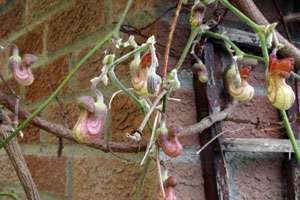
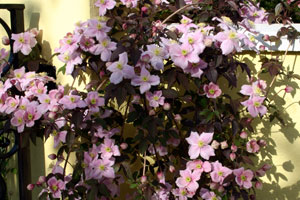
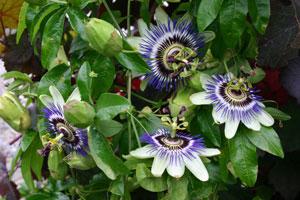

|
Happy Volunteers!
Born in the garden, the self-sown plant is one of nature’s gifts, but whether it’s going to be to the gardeners liking or not is quite another thing! Some of them will be treasures to cherish for a lifetime, others white elephants, tolerated but not really wanted, and then there are those that will become the bane of your life. Most of these plants you will have introduced into your own space at some time or another but on occasion you might come upon the ‘gatecrasher’, the seed that came in on the wind or on the fur of your pet from a neighbouring garden. These freebies are a bit of a lottery with that one-in-a-million chance of hitting the jackpot!
So let’s look at some of the self-seeders that would be a welcome addition, starting with perennials. Verbena bonariensis is a deservedly popular plant, growing up to two metres tall. With purple flowers sitting on top of each it’s ultra thin wiry stems and dinky, nearly undetectable leaves, this airy plant has an almost transparent effect, which allows it to grown in just about any setting. Let this pop up where it chooses and you will enjoy many combinations that you wish you’d thought of yourself. Aquilegias are prolific seeders and as the seeds are quite heavy they tend to drop and germinate at the feet of their parent. Thin ruthlessly as with these you really can have too much of a good thing! All sorts of Primulas will multiply happily, and it is quite common to see thick carpets of candelabra-type seedlings growing in amongst established plantings. These would always be a welcome addition to the plant sales table at your local club. The little golden feverfew, Tanacetum parthenium ‘Aureum’ is a short-lived perennial that is happy to share its offspring with you. Bright, cheery-looking plantlets have the fortuitous habit of colour co-ordinating extremely well with lots of other plants. If your fellow gardeners offer praise for your skills combining this plant so tastefully, just accept it and say a quiet thanks to Mother Nature. Echiums look like monsters that have just arrived from outer space and found a resting place in your garden. Huge rosettes of leaves form very quickly from unbelievably tiny seeds. E. pinninana stays at this rosette stage for two to three years before it decides to send up a huge flowering spike that is up to four metres tall. Once the flowering is over the last of the plants energies is put into seed production and then it dies. This may seem very sad, but the thought of all of those seedlings growing for you the next year should soon cheer you up! Many Geraniums self-seed and if it’s a choice one such as G. palmatum or G. maderense then consider yourself lucky. The young plants that start growing in the wrong place can easily be lifted and relocated.
Lots of annual plants self seed, which makes perfect sense when you remember that this is the only way that they can propagate themselves, so there is endless choice in this category, but here are a few that you might like to try. The opium poppy, Papaver somniferum, is a true delight with flowers in shades of purples, pinks, reds and whites this really is a godsend. After the petals drop the large central pods are revealed one by one. These stand sentry-like until the seeds within have ripened enough to be shed. If you want to distribute these to other locations, shake the pods over the desired area and watch the black seeds tumble out like pepper from a pot. Borage is a pretty blue flowered annual herb that will reappear all by itself from year to year, which is just as well as the seeds are very fiddly to harvest by hand. Orlaya grandiflora is a special annual umbellifer, a plant belonging to the cow parsley family. Fine ferny foliage is topped with the most beautiful pure white plates of flowers, tight in the centre, with an outer ray of larger petals. The seeds are flat and covered in small barbs, which means that they can be carried around the garden on the sleeve of the gardener or the fur of a cat and turn up the following year in a most unexpected place. Lunaria is an old fashioned biennial known by the common name of Honesty. It isn’t seen very often in modern gardens, which is a shame as that means a lot of people miss out on it. Try growing a few plants from seed and then once it is established it will do it’s own thing year after year. Big ornamental silver papery discs adorned the plant in autumn, and these are filled with flat seeds stored between three thin membranes, which open later on to release their load. The usual form has purple flowers, but exciting white flowered and variegated types are also available. Chenopodium giganteum, also known as ‘tree spinach’ is an amusing edible annual. Reaching almost 2 metres tall the new growths are covered in what appears to be a deep pink crystalline powder. Don’t go for overkill with this plant, just one or two in the garden make for an interesting talking point, any more and there’s a danger of them looking like giant weeds! Cerinthe major ‘Purpurascens ‘ is a highly desirable annual that self sows every year when it is happy. Start the seeds off in situ, they really don’t enjoy life in a pot at all. Gravel seems to be a favourite of theirs, or banks and dry stone walls, in fact anywhere that the soil is dry and impoverished. If you’ve failed with them in the past then now is a good time to try them again. The little forget-me-not is always a joy, forming frothy carpets of blue or white flowers. At their peak these are really romantic looking, but once they start to decline they blacken and the temptation is to pull them out to tidy the place up. Before you do this make sure they are starting to shed their seeds and give a helping hand by shaking the plants over the ground before tossing them into the wheelbarrow. Euphorbia lathyrus, the caper spurge is a fun thing. In the first year this quirky biennial grows into a robust, bizarre, single stemmed plant reaching up to two metres tall. It is clothed in a circular arrangement of leaves, which I often fancy might in fact be rungs for fairy’s to climb up and get a better view of the garden. Evergreen, it goes through the winter and then one fine day, as if to catch you by surprise, the curious beaky heads start to explode, emitting big seeds that take flight and touch down far away, and there they germinate ready to entertain you again the following year. If you have a sense of humour you will enjoy this fellow!
The next set of plants are the ones that have too many offspring for comfort, but being so nice you find it impossible to harden your heart and pull them out. Astrantias are a classic example as they will provide the garden with many progeny but you should not expect your named cultivars to come true from seed. ‘Shaggy’ or ‘Ruby Wedding’ will throw out many disappointingly drab looking youngsters, which, if left alone will swamp out the parent plant. Doronicums are lovable rogues. Their wind borne seeds are likely to turn up anywhere, growing into bright yellow flowers that clash and cause chaos wherever they go. And being so robust and healthy-looking it is hard to bring yourself to weed them out. Meconopsis cambrica, the Welsh Poppy, is a jolly thing, with bright sunshine-yellow flowers in May and June, but they increase at an alarming rate. If you really want to keep this in your garden, take time to deadhead before the seeds are released. Fennel is a very useful plant, especially the bronze leaf forms. The unique feathery foliage is a great foil to other plants, particularly anything with big leaves. It’s wise to cut this plant back before the seeds are ripe as the rash of babies might annoy you, especially as not all of them share the same bronze colouring as their mum.
Some people think that any plant deserves a place in the garden, but for the next batch that place is the compost heap. But only after they have been beheaded and the seed heads are safely in your wheelie bin. Some years back Haloragis erecta ‘Wellington Bronze’, a semi-tender evergreen perennial was hailed as a thrilling new find from New Zealand. This ‘star’ was introduced into this part of the world to add an exciting dimension to planting combinations as it had unique chocolate-brown serrated leaves. In fact what it did do is produce prolific clusters of knobbly seeds that it shed with wild abandon. This resulted in carpets of seedlings, which didn’t even have the courtesy of dying back for the winter and far from being ‘semi-tender’ it happily shrugged off minus 10C frosts. Once in the garden this plant is there to stay. Duchesnea indica, the Indian Strawberry could easily be mistaken as a little ‘dote’. On paper it looks good, a ground covering plant with yellow flowers followed by masses of tiny ornamental strawberries. But beware, this plant spreads by producing lots of runners and if that wasn’t bad enough the birds eat the fruits and then distribute the seeds to every corner of the garden. And before you know it there’s no place safe left. Impatiens glandulifera. Remember that name and if anybody offers you seeds or plants of it, run. Run away as fast as you can! This annual starts off so promisingly, with its fast growing fleshy stems and leaves soon joined by exotic, orchid-like purple flowers. At over a metre tall this well branched plant looks marvellous all summer long. Then one warm evening you’ll brush past it and hear a little ‘pop’. Then another. Then another. This noise is one you will learn to fear, as it is the sound of the seed capsules exploding and firing their contents far and wide. The seeds will find a home in every nook and cranny imaginable, including tree fern trunks. Lawns are littered with them, as you will soon notice when the seeds start germinating the next spring. Violas are pretty little things and most people wouldn’t object to a bit of self-seeding. But beware of V. riviniana ‘Purpurea’. The tiny purple flowers turn into spring mechanisms loaded with seeds. These land everywhere and soon develop into suffocating carpets of foliage. They are lovely for a wild area or woodland bed, but not for an herbaceous border. The plant sales table at your local flower or garden club is the prime location for these sneaky villains to hang out at, but rather than trying to put you off buying from them I am sending out a plea to all those people who donate plants. Think carefully before you bag up that Alchemilla mollis. Yes, you’re giving it away because you have plenty of it, and we know why that is don’t we? It seeds like a mad thing and gets everywhere including into the middle of all your precious things. Put the bag away and pop that plant on the compost heap instead. If you have a problem with a plant, it best not to share it with others.
Finally in among the jungle of seedlings that your garden produces, keep a watchful eye out for that something special. Give that unusual looking seedling a chance to grow. You never know, it might turn out to be as wonderful as the lovely orchid that came to live with me.
By Deborah Begley
|
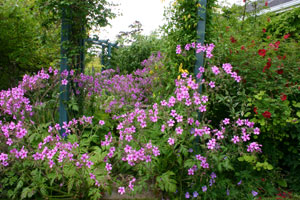
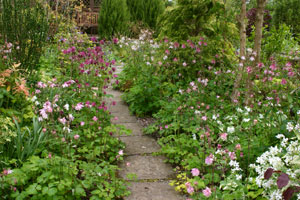
|
Home About Us Photographs Reviews Articles Events Plants Seeds Location Links
|
![]()